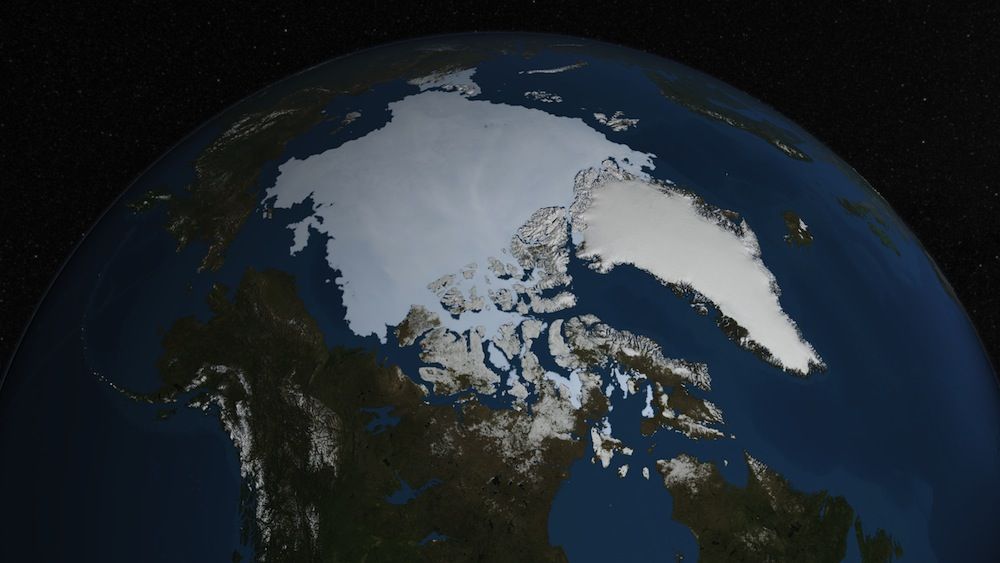It has been a focus of attention in recent years largely because of a strong decrease in the Arctic sea ice cover and modeling results that indicate that global warming could be amplified in the Arctic on account of ice-albedo feedback. The Argus-Press Google News Archive Search.
And Now It S Global Cooling Return Of Arctic Ice Cap As It Grows By 29 In A Year Daily Mail Online
The animated time series below shows the annual Arctic sea.

Arctic ice cap. And a Nobel laureate predicted the ice would be gone five years ago. Brave the blustery winds and snowfall for an opportunity to witness the stunning northern lights and the stillness of. Ice caps and ice fields are found far beyond polar regions however.
Emma Hatcher Pre - Lab Questions 1. Bad News Alarmists Official Data Reveals Arctic Sea Ice is once again GROWING January 29 2020 January 30 2020 Cap Allon According to official government data from the National Snow Ice Data Center NSIDC Arctic Sea Ice is once again GROWING with current 2020 levels exceeding 8 out of the previous 10 years. An unforgettable ice camping and trekking adventure.
The Arctic used to be white but now its turning blue and absorbing more heat in a feedback loop. BBC reported in 2007 global warming would leave Arctic ice-free in summer. The lighter coloured rings highlighted by arrows are ice layers formed by refreezing of meltwater that percolated down into the more opaque firn.
The effects of the melting ice cap on the wild life Some of the changes include. The worlds leading climate expert predicted the Arctic would be ice-free last year. Arctic Cold Caps is Recommended by the Rapunzel Project and by many hospitals and physicians throughout the US.
A collaborative network of scientists and stakeholders to advance research on sea ice prediction and communicate sea ice knowledge and tools. Arctic sea ice reaches its minimum each September. The changing arctic ice caps.
The Northern Hemisphere ice pack is shrinking as a result of climate change. The sea ice cover is one of the key components of the polar climate system. The average rate of decrease in the extent of the ice pack in September between 1979 and 2018 was 128 per decade 23.
Mountain ranges such as the Himalayas Rockies Andes and the Southern Alps of New Zealand are all home to many ice caps and ice fields. Acknowledgments Arctic Sea Ice News Analysis ASINA is produced by the National Snow and Ice Data Center NSIDC which is part of the Cooperative Institute for Research in Environmental Sciences CIRES at the University of. Stay overnight on the Greenland Ice Sheet.
- significant amount of ice melting and falling into the oceans -. September is usually the month with the least amount of sea ice in the Northern Hemisphere. Weve all seen the pictures.
533000 more square miles of ocean covered with ice than in 2012. The Arctic affects the jet stream causing extreme weather all over the world. Our unique 8 Cap System is easy to use and very effective in helping more patients particularly those with the most aggressive treatments to save their hair.
NASA Releases Time-Lapse Video Of Depleting Arctic Ice Cap - YouTube. This graph shows the average monthly Arctic sea ice extent each September since 1979 derived from satellite observations. Close to 50 years of data show the Devon Island ice cap one of the largest ice masses in the Canadian High Arctic is thinning and shrinking.
Feel natures veritable strength amidst a Greenlandic summer or winter. A 16 m long ice core from the Devon Ice Cap Nunavut Canada. The largest ice cap in the world is probably the Severny Island ice cap part of the Novaya Zemlya archipelago in the Russian Arctic.
Every year it expands and thickens during the fall and winter then grows smaller and thinner during the spring and summer. Polar ice cap may disappear by summer 2014. A forlorn polar bear stranded on an ice floe - the living symbol of global warming melting the ice caps.
His science fiction movie has been shown to nearly every public school child in the world. What changes are occurring in the Arctic ice cap. The Arctic sea ice cap is an expanse of frozen seawater floating on top of the Arctic Ocean and neighboring seas.
Effects of the Melting Arctic Ice Cap By. NASA Releases Time-Lapse Video Of Depleting Arctic Ice Cap. The ice pack melts and breaks up over the summer.
Insights from ice cores. Return of Arctic ice cap as it grows by 29 in a year. September Arctic sea ice is now declining at a rate of 131 percent per decade relative to the 1981 to 2010 average.
Nasa Releases Time Lapse Video Of Depleting Arctic Ice Cap Youtube
Polar Vortex Grows Arctic Sea Ice To 10 Year High But There S A Catch The Weather Channel Articles From The Weather Channel Weather Com
2019 Arctic Sea Ice Maximum Continues Trend Of Decline Youtube
Nasa Arctic Sea Ice Hits Smallest Extent In Satellite Era
Arctic Sea Ice Is Growing Faster Than Before But There S A Catch
Happening Now Arctic Sea Ice Sets Record Low Ocean Today
Nasa Nasa Finds Thickest Parts Of Arctic Ice Cap Melting Faster
September 2018 Arctic Sea Ice News And Analysis
2019 Arctic Sea Ice Minimum Tied For Second Lowest On Record Climate Change Vital Signs Of The Planet
Unexceptional Arctic Sea Ice Maximum In 2020 Noaa Climate Gov
Arctic Sea Ice Shrinks To Second Lowest Level On Record Time
Shrinking Arctic Ice Will Lead To Ice Free Summers Live Science
So Much Arctic Ice Has Melted That We Need A New Atlas Quartz

No comments:
Post a Comment
Note: Only a member of this blog may post a comment.